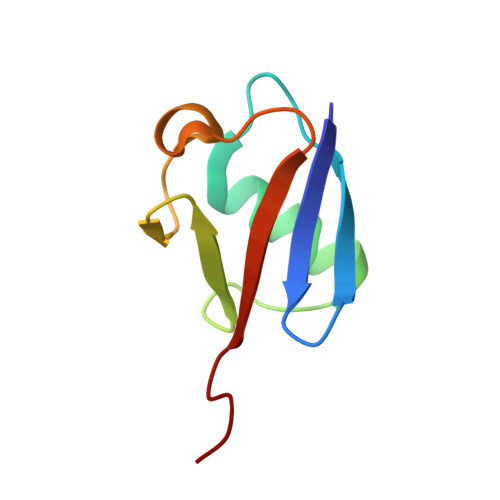Linkage via K27 Bestows Ubiquitin Chains with Unique Properties among Polyubiquitins.
Castaneda, C.A., Dixon, E.K., Walker, O., Chaturvedi, A., Nakasone, M.A., Curtis, J.E., Reed, M.R., Krueger, S., Cropp, T.A., Fushman, D.(2016) Structure 24: 423-436
- PubMed: 26876099
- DOI: https://doi.org/10.1016/j.str.2016.01.007
- Primary Citation of Related Structures:
5UJL, 5UJN - PubMed Abstract:
Polyubiquitination, a critical protein post-translational modification, signals for a diverse set of cellular events via the different isopeptide linkages formed between the C terminus of one ubiquitin (Ub) and the ɛ-amine of K6, K11, K27, K29, K33, K48, or K63 of a second Ub. We assembled di-ubiquitins (Ub2) comprising every lysine linkage and examined them biochemically and structurally. Of these, K27-Ub2 is unique as it is not cleaved by most deubiquitinases. As this remains the only structurally uncharacterized lysine linkage, we comprehensively examined the structures and dynamics of K27-Ub2 using nuclear magnetic resonance, small-angle neutron scattering, and in silico ensemble modeling. Our structural data provide insights into the functional properties of K27-Ub2, in particular that K27-Ub2 may be specifically recognized by K48-selective receptor UBA2 domain from proteasomal shuttle protein hHR23a. Binding studies and mutagenesis confirmed this prediction, further highlighting structural/recognition versatility of polyubiquitins and the potential power of determining function from elucidation of conformational ensembles.
- Department of Chemistry and Biochemistry, Center for Biomolecular Structure and Organization, University of Maryland, College Park, MD 20742, USA; Departments of Biology & Chemistry, Syracuse University, Syracuse, NY 13244, USA. Electronic address: cacastan@syr.edu.
Organizational Affiliation:
















